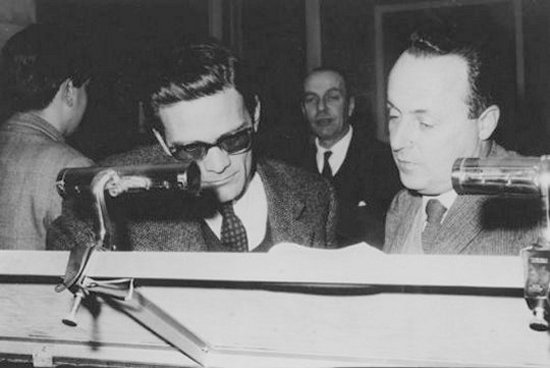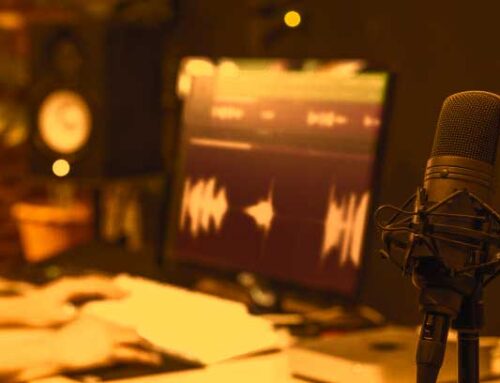History of Dubbing. From the “TEMPO” Magazine, August 1, 1940 – An Article by D.M. (Thanks to Aurora Del Bandecca)
In recent years, there has been a growing cinematic collaboration between Italy and Germany, involving the production of films in dual versions and active film exchange. With recent agreements, this collaboration has become more intense.
German screening rooms have now become reliable customers of Italian cinema, which is recognition of the improved quality of our production. Therefore, dubbing studios are at work. Italian dialogue needs to be dubbed into German.
For a certain period, dialogue overprinting on frames was used, but it was observed that this method had the inconvenience of distracting and tiring the audience, who had to watch the image and read the lines simultaneously. Another drawback of this system is that the dialogue, shortened to fit the frame, becomes a poor representation.
Dubbing, perfected thanks to a category of writers and technicians who are now masters of every aspect of the craft, is a better option. The term ‘craft’ might not be the best fit.
In the process of dubbing, there is indeed a technical aspect, such as matching a word to the movement of the character’s mouth on the screen. It is also a technical skill to align new dialogue with the length of the original. The technical aspect includes reproducing the complex set of noises and sounds accompanying the action in the original.
However, the artistic challenge lies in avoiding banality, falsehood, or inaccuracy, and in retaining the original sense and atmosphere, both during the translation process and in the physical act of dubbing.
In dealing with difficult synchronization issues, some have opted to alter the dialogue to match the lip movements. This is an example of how an ill-conceived or unskilled translator or synchronization director can distort or worsen a work.
As in literature, the work of a translator in a way is creative, although in literature, the translator has more freedom than in cinema, where technical constraints are more binding.
On the other hand, dubbing is the result of the efforts of two roles: the translator and the synchronization director, who may be combined in one person, but are generally distinct. The synchronization director realizes the translator’s work and is responsible for restoring the merits of the original film to the new sounds.
Thus, the synchronization director faces a more challenging synchronization in certain aspects, and a simpler one in others compared to the original synchronization. The ideal scenario would be for the translator and synchronization director to collaborate, as their work complements each other – both are technicians and artists simultaneously.
Thanks to dubbing, many Italian films have already achieved significant distribution in several foreign countries, especially in Spain and Latin America.
In North America, Italian films are released with subtitled dialogue due to limited distribution, which prevents the significant expenses of dubbing. Now, due to the possibilities offered by dubbing, the distribution of Italian cinema, following new agreements, is also expanding in Germany.
Background Noise
It’s worth noting, from the top photograph, how much importance was placed on the physical attitude of the dubbing actors, to the point of placing them in the same positions as the characters they were covering. The image depicts a moment of dubbing for one of the many Tarzan films featuring John Weissmuller.
The two bottom photographs portray a chorus scene from a film and the equally collective work of the dubbing actors. The dynamics of the body have always been the basis of acting. Today, dubbing actors have learned to achieve the same results with less pronounced movements while at the lectern.
A Brief History of Dubbing
From the era of silent films to the present, much has changed, yet the topic of cinema continues to arouse interest and remains a daily event, not only in movie theaters but also in our homes through television.
I remember the early days of television, when the only Rai channel would broadcast one movie per week. We never missed one, as the rarity of the event made it all the more exciting. Today, however, we have a thousand channels, and often we switch from one to another, from one movie to another, without deciding which one to watch.
It’s the crisis of abundance, but it’s also evidence that cinema has become a part of our lives. Surely, this success is due to translation, which has allowed everyone to enjoy cinema, discover worlds distant from everyday life, understand, know, and dream.
Music, painting, and sculpture are universal languages that do not require translation. Literature, on the other hand, needs a counterpart in the spoken languages of different countries to be disseminated. The situation is the same for cinema. Before the advent of sound, it was sufficient to replace the title cards containing lines or narrative passages in the original language with translated versions, and essentially, the work remained the same. With sound, things became more complicated.
Cinema purists have never looked kindly upon dubbing or any other form of film translation; even subtitles are considered a kind of desecration by them, akin to seeing a portion of an artwork covered in text. Considering this, imagine their perspective on a process that goes so far as to replace the voices of the original performers.
Someone once wrote with horror: “…it is not about translating a dialogue, it is about translating an actor, that is, a human substance, imagination, and technique.” This idea is understandable but difficult to put into practice.
Cinema is and remains a commercial enterprise that requires significant financial investment for its production. Clearly, no producer can afford to think like a purist, and translation, in the broadest sense of the term, is necessary for the survival of cinema itself.
Any form of translation of a book or a film has a “distorting” effect, as the contents are expressed in another language with all the differences, however small, that come with it. A perfect translation can only be considered the one that comes closest to the original.
However, this is the only way we have to disseminate a literary or cinematic work.
The first rule for a translator should therefore be to respect the author’s intentions and the value of the original work as much as possible. In 1927, the invention of sound in cinema created the need to distribute spoken films abroad. American production companies realized that they could not neglect the European market and that Europeans would demand more than just subtitles.
The Italian market was particularly receptive. However, the fascist regime opposed the spread of foreign languages and other cultures in Italy from the outset, banning the screening of foreign-language films on our territory with a law passed in 1930.
Importers were forced to step back, i.e., to mute sound films. However, as the narrative style had changed, the intertitles inserted between scenes became too long, impractical to read, and disliked by the Italian audience. At that time, there were few cinemas equipped with sound systems, so the situation remained unchanged for a while.
Slang and Idioms in Dubbing
Adaptation
This term refers to two distinct processes. One is the transformation of a literary, theatrical, or musical work into a film subject, as in the case of Shakespeare’s tragedy “Romeo and Juliet” adapted into the American musical “West Side Story” by Robert Wise, with music by Leonard Bernstein. The other process involves writing the script for dubbing, where phrases of the same length as those in the original language are composed in film frames and the dubbing actor is provided with instructions regarding camera angles and the character’s position in relation to the camera.
Frame
It refers to a single image in a filmstrip. In dubbing, frames are the individual units that the dubbing actors work with, each containing a specific amount of dialogue or action. The precise synchronization of the dialogue with the on-screen action is crucial.
Attack
The beginning of a line of dialogue.
Attack “à la Photographic”
This term is used by the Dubbing Director and the Dubbing Assistant to alert the dubbing actor that a specific line of dialogue starts precisely at the first frame of a camera angle change. This sudden and unpredictable entrance might catch the actor off guard.
Original Soundtrack
The sound part of the film in its original language, serving as the reference point for all stages of dubbing.
Guide Track
An alternative term for the Original Soundtrack, which the dubbing actor listens to through headphones while at the lectern. If you hear someone refer to it as the “base,” they likely have experience in recording studios. The musical base is the orchestral recording of a song without the vocal part.
Separate Track
The recording of dialogue by a single dubbing actor, who records their lines separately from the other characters.
Separate tracks are primarily used when a dubbing actor is not available for scheduled recording sessions due to various reasons. It’s a sort of solo recording to better illustrate the concept. Today, with the help of technical equipment that allows us to hear other dubbing actors’ recordings, the use of separate tracks is frequent for convenience in soap operas and TV series dubbing.
The ability to listen to previous recordings helps the Dubbing Director tune all the dubbing actors as if they had recorded the lines together, simultaneously. In some cases, separate tracks are necessary when there are dialogues that need post-production treatment, such as phone conversations. For example, one of the voices in a telephone call dialogue will be filtered to sound like it’s coming through a phone. This technique creates the feeling of hearing the complete dialogue as if from the perspective of the character receiving the call. We could call it a sonic point of view.
Another example involves a dialogue taking place outdoors where the characters are at varying distances from the camera. Since the movement towards or away from the camera is adjusted during post-production by the sound technician, to ensure accuracy and avoid overlap, the recordings are made on separate tracks. These are just examples; the cases where separate tracks are needed are numerous.
Door Effect
In scenes where one or more characters are speaking off-screen from behind an obstacle, usually a door or a wall, the Dubbing Assistant places a screen, the box of a reel of magnetic tape, or a video cassette container in front of the microphone.
The voice doesn’t directly hit the microphone diaphragm; instead, it arrives from behind, creating a realistic effect. Door effects are recorded on separate tracks during the sound recording, as they are difficult to recreate accurately in post-production.
Making Distance
Making distance refers to moving away from the microphone. In indoor scenes, the dubbing actor must maintain a distance from the microphone that mirrors their character’s distance from the camera.
If the character is in a long shot, the dubbing actor must move away from the microphone to recreate the room’s sound, thereby achieving the same acoustic conditions.
Similarly, if the character moves towards or away from the camera, the dubbing actor adjusts their position in relation to the microphone accordingly. These are effects that are hard to reproduce accurately in post-production and, in most cases, would sound unnatural.
It’s better to record these distance variations while recording individual frames. It’s important to emphasize that this recording technique is used only for indoor scenes. Outdoors, dubbing actors need to be closer to the microphone, and distance effects are added in post-production by the sound technician, who adjusts the level of the signal to create the sense of moving away.
Final
The concluding part of a line of dialogue.
Out of Rhythm
Refers to a dubbed line with correct attack and ending but an internal rhythm that isn’t in perfect sync. In this case, the dubbing actor re-records the line, aligning more with their character’s pacing.
This occurs when there are hesitations or imperceptible nuances during a line that aren’t clear breaks and can’t be categorized in any specific way. It falls into the realm of interpretation, as discussed in the general introduction—difficult to describe but easier to perceive.
Out of Sync
Refers to a dubbed line that is either too short, too long, out of rhythm, or otherwise impossible to synchronize accurately even in post-production.
Magnetic
Perforated magnetic tape (16 or 35 mm) used in the editing process containing the guide track, soundtrack, sound effects, or recorded dialogue to be synchronized.
Optical
A film print (16 or 35 mm) of a movie without a soundtrack.
Over Sound
An Italian term for the overlaying of dubbing over background dialogue remaining in the original language. This technique is widely used in television programs or documentaries when interviews with characters alternate with the narrator’s voiceover. The correct English term for this technique is “Voice Over.”
Sync
Short for synchronization or synchronism.
Voice Match
Refers to the perfect alignment of a dubbing actor’s voice with the on-screen actor’s appearance.
Often, the ideal combination differs significantly from reality. For instance, the dubbed actor’s vocal characteristics may be vastly different from the original performer’s or the dubbing actor may physically differ from the on-screen actor.




















